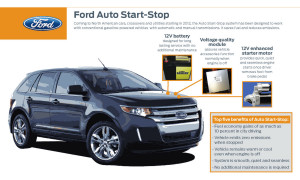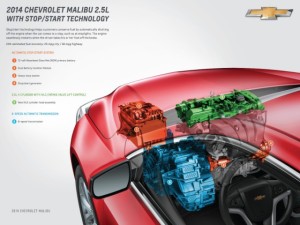Start-Stop Is an Invasion That’s Started – And We’re Not Talking About Hybrids
It’s coming and it’s coming in a big way. Ford announced last week (Dec. 12, 2013) that 70 percent of its North American vehicle lineup will feature start-stop by 2017, which is essentially tomorrow in the automotive world that is in the 2014 model year and already introducing 2015 models. That came on top of analysts noting that 45 percent of European vehicles already feature start-stop, where it’s more widely accepted. Most current American vehicles featuring start-stop are hybrids, but this new breed takes the technology into a much broader market.


One of the simplest ways to reduce vehicle fuel consumption is to shut off the engine when it is not being actively used. Other than hypermilers, few of us turn the engine off when we stop at a traffic light or when at a fast food drive-thru and turn it on when it’s time to go – and in many older cars it might not even result in real fuel savings. That’s where stop-start technology comes in, so get ready for its invasion. In simple words, stop-start systems automatically shut the engine off every time the vehicle stops, such as at a traffic signal, and restart it instantly when needed.
The idea of stop-start dates back to the 1930s, and its use can be traced back to the 1980s by European automakers Volkswagen and Fiat. Gasoline-electric hybrids from Honda and Toyota introduced American drivers to stop-start systems more than a decade ago. Today, it is a feature of every hybrid vehicle in the market. For conventional gas- or diesel-powered non-hybrid vehicles, stop-start is a relatively low-tech, low-cost solution that moderately improves fuel economy as well as reducing tailpipe emissions.
These systems are also known as micro hybrids, start-stop, idle-stop, idle-elimination, and a variety of names branded by automakers such as Auto Start-Stop (Ford) and Eco Start/Stop (Mercedes-Benz).
Fuel Economy Savings
Depending on the system design and driving environment, stop-start by itself can add 3-10 percent to MPG numbers. Combined with other fuel efficiency technologies such as direct fuel injection, electric power steering, electric-powered air conditioning compressors, as well as regenerative braking, fuel economy gains can reach 15-20 percent improvement. Stop-start systems make an appealing option for automakers: they don’t require serious design or engineering changes, unlike hybrids and electric vehicles, and the benefits can quickly outweigh the relatively small cost.
Since stop-start operates when the engine is warm and lubricated, there is very little, if any, additional engine wear. They do demand, however, a lot from vehicle batteries. In addition to calling on the battery for engine ignition and starter-motor several dozen times a day, it must provide electrical power for climate control systems and maintain audio and lighting each time the engine shuts down.
Bring in the New Batteries
Conventional 12-volt lead-acid batteries aren’t designed for such punishment so automakers are turning to what’s called Absorbed Glass Matt (AGM) batteries. An AGM battery’s advantage is it recharges up to five times faster and can be deeply discharged with no damage. Like all automotive batteries, it will need replacement. Be prepared to spend two to three times the cost of a regular 12-volt battery. In addition to an upgraded battery, stop-start requires a beefier starter/alternator. Also, specific software programming is required to ensure the system performs properly. That means when the brake pedal is released – or clutch pedal if equipped with a manual transmission – the vehicle takes off quickly as well as smoothly.
Here They Come
In 2003, General Motors began offering stop-start on its full-size Chevrolet Silverado and GMC Sierra pickups. With a 295 horsepower 5.3-liter V-8 and a four-speed automatic transmission, the EPA estimated city fuel economy at 16 MPG was 2 mpg better than the standard model (Highway fuel economy was the same at 19 MPG since start-stop has little impact in that mode.). For a variety of reasons, including a $2,500 additional cost, GM ended sales in 2006 with only a few thousand sold.
Production vehicles with stop-start technology began emerging in Europe in 2007. This was in response to stringent and escalating European emissions targets. The European Union has mandated that automakers’ fleets average 130 grams of CO2 per kilometer by 2015, with a target of 95 grams by 2020 – slightly more efficient than the 54.5 mpg proposed by the Obama administration. Today, nearly 50 percent of all light-duty vehicles sold in Europe are equipped with stop-start systems. That includes high-end performance cars from Ferrari and Lamborghini. Lux Research, a global automotive market research firm that has analyzed start-stop technology for several years, predicts that the European stop-start market will grow from more than 4 million units in 2011 to nearly 13 million units by 2017. European automakers began exporting vehicles with stop-start to the United States in 2012, including Audi, BMW and Mercedes-Benz. Added in 2013 were cars from Porsche, Jaguar and Volvo.
Prompted by the government’s CAFE (Corporate Average Fuel Economy) increase to 35.5 miles per gallon in 2016 and a requirement of automakers to raise the average fuel efficiency of new cars and trucks to 54.5 mpg by 2025, U.S. automakers are also turning to stop-start. In 2012, General Motor’s Buick division introduced a sophisticated stop-start system to its mid-size LaCrosse sedan. Called eAssist by GM, the system is now available on the Buick Regal and Chevrolet’s Malibu. Ford and Chrysler each put their toes in the start-stop water in 2013. Ford’s system is available on the 2014 Fusion SE sedan as a $295 option, while Chrysler’s stop-start is standard on the 2014 Ram 1500 HFE pickup truck. Chevrolet also added a no cost light stop-start system (see below) to the base Malibu model. The numbers may be small now but Lux Research has forecast that the North American stop-start market will grow from minimal in 2011 to more than 8 million by 2017.
Stop-Start System Types
Not all stop-start systems are created equal. Lux Research segregates stop-start systems into three broad classes: light, medium and heavy.
Light Stop-Start
The most simple and least expensive, light stop-start systems employ a higher durability starter and a more powerful and longer lasting battery. Also, the engine controller requires reprogramming to pre-position the fuel injection system, starter and transmission to provide instant engine restart when the driver either releases the brake or clutch pedal. Most light stop-start systems include a driver-selectable on-off switch, and some add a small auxiliary battery to eliminate a momentary dimming of lights or slowing of the air-conditioning fan when the engine stops and starts. Extreme hot or cold weather can prevent systems from activating.
The light stop-start feature doesn’t use an electric motor and batteries to move the car down the road and is not considered a hybrid by many standards. Because of their mechanical simplicity, a stand-alone light stop-start system only costs $300-$400 more than a conventional vehicle. Fuel economy improvement is 3-5 percent, slightly more if most of the driving occurs on city streets and stop-and-go traffic. The majority of stop-start systems employed in gas-powered vehicles sold in the U.S. fall into the light category.
Medium Stop-Start
Like a light stop-start system, a medium stop-start version uses a beefed-up starter, more powerful battery and usually an auxiliary battery. In many medium systems, an enhanced alternator is used that allows regenerative braking to recharge the auxiliary battery, usually a small lithium-ion. Medium start-stop systems add $500 to $700 to the price of a conventional vehicle. Fuel economy improvement is 7-12 percent, and again, slightly more if most of the driving occurs on city streets and stop-and-go traffic. There is yet a vehicle with medium start-stop to be offered in the U.S.
Heavy Stop-Start
Heavy stop-start systems offer the highest level of functionally. They are most often a design called Belt Alternator Starter (BAS) or, in Europe, Belt-Driven Starter-Generator (BSG). A BAS is integrated into the belt drive system of a conventional combustion engine. It replaces the belt driven alternator with an electric motor that serves as a generator and a motor. Thus, when the engine is running, the motor acting as a generator will charge a separate battery. When the engine needs to be started, the motor then applies its torque via the accessory belt, and cranks the engine instead of using the starter motor. The separate battery is also recharged via a regenerative braking system.
In this scheme, the motor/generator is made larger than a standard starter motor so more torque can be generated when in the motoring mode. This allows for quicker starts of the engine, and makes the stop-start operation possible. A BAS system is fairly sophisticated and, in addition to the stop-start function, can enhance fuel economy even during highway driving by cutting off the fuel supply when cruising or decelerating. Some systems can also provide some electric assist to the engine during acceleration, but not all-electric operation – thus the term “micro-hybrid.”
When an automatic transmission is part of the drivetrain equipped with BAS, an auxiliary electric-driven oil pump is added to the transmission. This keeps it primed and the fluid flowing when the engine shuts down at a stop. That sustains the transmission’s readiness to perform when the driver accelerates. A BAS heavy stop-start system can add $1,000 to $2,000 to the price of a car, but fuel economy gains are 15-25 percent or more. GM’s eAssist is considered a heavy system.
Actual Mileage Will Vary
In its recently published Fuel Economy Guide for model-year 2014 vehicles www.fueleconomy.gov , the federal Environmental Protection Agency notes for the first time vehicles with stop-start with the abbreviation “SS.” It includes both conventional as well as hybrid powertrains. What the guide doesn’t tell you is the official EPA fuel efficiency test cycle doesn’t include much idling time. Therefore, fuel savings provided by stop-start aren’t reflected in the official fuel economy ratings. That will change when the new 2017-’25 fuel-efficiency standards are published. It will include extra credit for “off-cycle” systems such as engine stop-start. Until then, you will just have to trust that the stop-start fuel economy gains claimed by auto companies are truthful.
It would appear that there are no reasons to doubt them. Though battery electric vehicles are the current sexy topic, stop-start is poised to become the real fuel saving technology revolution in automotive history. The reason for the breakneck ramp up is simple – it works and it doesn’t cost that much. Stop-start technology won’t be optional, but will soon be standard equipment. So, don’t be surprised if the next car, truck or SUV you purchase shuts off its engine at the first stop light – and enjoy the fuel savings it offers.
Story by Larry E. Hall; photos from the manufacturers
Other related stories you might enjoy:
Overview: Ford Fusion With Start-Stop
The Top 10 Best Fuel Economy Cars for 2014
Cars & Technology of the Future
Top 10 Markets for Electric Cars

Thanks for sharing this very informative post. It’s amazing how far cars have come, that they will shut off and start again at a light. Can’t wait to see what the future has in store.
The technology is pretty amazing. Check out our latest review of the new Ford Fusion SE that features start-stop at https://cleanfleetreport.com//overview-2014-ford-fusion-stopstart/. –Ed.